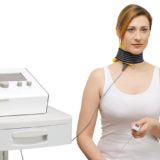Highlightfeatures
- Diagnosis and treatment of larynx pareses and difficulties in swallowing
- Voice training supported with electrotherapy with phonation exercises in the device
- Differentiated diagnostics menu with grading of degrees of damage and metering of accommodation quotient
- Electrotherapy with 13 current forms
- Manual release key for emergency shut-off or intentional exercises
Medium frequency currents:
- AMF (Bipolar interference current)
- MT (Medium-frequency muscle stimulation)
- KOTS (current mode)
Low frequency currents:
- G (Galvanisation)
- UR (Ultra stimulation current acc. to Träbert)
- IG 30 (Pulse galvanization 30)
- IG 50 (Pulse galvanization 50)
- FM (Frequency-modulated current)
- FaS (Faradic surge current)
- T/R (Pulses with adjustable parameters)
- (T/R alt) (Pulses with Adjustable Parameters)
- (T/R sync) (Pulses with Adjustable Parameters)
- TENS (Transcutaneous Electric Nerve Stimulation)
Diagnostic
- Accommodation quotient
- Intuitive PHYSIOMED one-button operation
- Comprehensive overview of the therapy parameters
- Fastest therapy start: direct, through program memory, patient smart card or indications index
- Extensive treatment index featuring therapeutic information, dosage proposals and application graphics
- Patient database and potpourris
- Individual: personalized history
- Dual-channel technology (time alternating and synchronous)
- Color touch display
- Integrated audio player
Therapist or doctor may use a diagnostic program to quantify the degree of damage before the start of treatment with vocaSTIM®. After determining the degree of damage to the patient, the latter
is automatically included in the personalised menu navigation. Therapy settings, electrode system and exercises are thereby tailored precisely to the degree of damage determined.

Audio player built in with vocal- and tonal exercises

Guided, self-explaining diagnostics menu with automatic transfer of the value to the indication menu
Therapy training based on the clinical picture and the intensity of the treatment
Improvement of voice quality
Compared to conventional voice therapy, the 3-month treatment with vocaSTIM® for unilateral larynx pareses leads to a significant improvement to the irregularity index (CFx).
Ptok M., Strack D. (2008): Electrical stimulation-supported voice exercises are superior to voice exercise therapy alone in patients with unilateral recurrent laryngeal nerve paresis: results from a prospective, randomized clinical trial. Muscle Nerve 38:1005-1011.
Therapy information
vocaSTIM® is a concept for the diagnosis, therapy and therapy process control of larynx pareses. Following anamnesis, diagnosis and instruction by a doctor or therapist, the patient can normally continue autonomous therapy or voice training independently. Process control is carried out at regular intervals by the attendant therapist.
Standardised therapy with Neuro Muscular Electro Phonatory Stimulation (NMEPS) according to Prof. Pahn is based on electrostimulation of the damaged musculature in the form of intentional exercises. While the patient attempts to trigger voluntary contraction, at the same time, a supporting electric pulse is triggered manually be means of a manual release key. The current parameters used are determined by a diagnostic procedure which is carried out initially and as part of therapy progress control. The parameters are customised exactly to the indication and degree of damage.
Electro diagnostic methods are used to initially detect the degree of damage and to monitor the therapy process for peripheral pareses. In physical therapy, in particular the so called I/T curve has established itself, providing substantial and relatively exact results on the one hand while being very costly and time consuming in its realization. Because it is easy and quick to implement, the determination of the so called “accommodation quotient“ (ACC) has proven to be of value as a means of electro diagnosis in the context of NMEPS and NMEAS. The diagnosis is based on the physiological phenomenon of accommodation ability that shows significant differences between damaged and intact motor nerves: a damaged/ denerved nerve-muscle system suffers losses of accommodation ability or even loses it completely. When stimulated with adequate electrical pulses, it for this reason reacts even at considerably lower amperage then a healthy one. The varying accommodation ability does not only form the basis for the accommodation quotient as a quantitative function check, but also for selecting the electrical pulses appropriate for therapy. vocaSTIM®-Master has a menu to determine the accommodation quotient conveniently, and additionally offers the possibility to operate the device via foot switch in order to have your hands free for the laryngoscopy needed at the same time.
In general, the electrotherapy treatment unit with vocaSTIM® consists of two sequences:
- the so called preheating with appropriate current types for promoting blood circulation
- the actual neuromuscular electro-phonatoric/ electro-articulatory stimulation with appropriate pulses (NMEPS/ NMEAS)
Selected use cases
Therapy with vocaSTIM® is beneficial within a broad range of applications, including, but not limited to:
- Larynx pareses




















